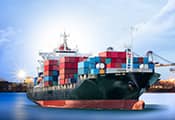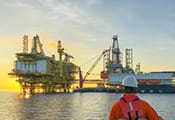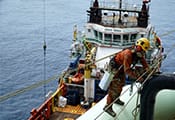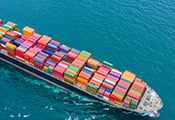Types of Marine Losses
Marine losses are broadly classified into two namely, total loss and partial loss. Let us look into the details
Total loss
The first type of marine loss is Total Loss. A total loss occurs when the insured property or cargo loses 100% or nearly 100% of its value, or when the insured is irretrievably deprived of it. Total loss can be further divided into two subcategories: actual total loss and constructive total loss.
-
Actual total loss
An actual total loss is a complete and physical loss of the insured property. It occurs under the following conditions:
- The insured cargo or goods are completely or irreparably damaged, such as when a storm or fire sinks a ship, or seawater spoils perishable goods.
- The insured cargo or goods are inaccessible, such as when pirates capture a ship or thieves steal valuable goods.
- The vessel transporting the shipment is missing with no reasonable chance of recovery, such as a ship lost at sea with no news for a long time.
When an actual total loss occurs, the insured business is entitled to the full value of the insured goods according to the policy. The insurance company pays the claim and takes ownership of the goods or their remains. If the goods are found later, the insurance company has the right to claim them.
Here is an example, suppose you export some furniture from India to the UK and have paid ₹50 lakh as their market value. Unfortunately, the ship carrying your goods catches fire and sinks in the Indian Ocean. Since you lost your entire shipment of furniture, your policy entitles you to a compensation of ₹50 lakh. If any parts of your goods are ever found, the insurance company will claim ownership.
-
Constructive total loss
A constructive total loss allows you to claim a total loss when the cost of saving or repairing the insured goods is more than their value after the loss. This happens under the following conditions:
- The insured goods are not completely destroyed but are so damaged that restoring them would cost more than their value. For example, a fire damages a ship, but it can still float.
- You can only access the goods by spending more than their value. For example, a ship is stranded on a remote island but can still be salvaged.
- You choose to abandon the insured goods because saving or repairing them is not worthwhile. For instance, your ship is in a war zone but can still escape.
In a constructive total loss, you can abandon the insured goods and claim the full policy value, or keep them and claim a partial loss based on their condition. The insurance company will decide on acceptance and payment.
For example, suppose you import some machinery from Germany to India and have paid ₹30 lakhs as their market value. You also take a marine insurance policy to cover the goods for any loss or damage during transit. Unfortunately, the ship carrying your goods gets stranded on a reef near the Maldives, and most of your machinery is damaged.
You can salvage the remaining machinery, but it will cost ₹25 lakhs. Since your machinery is worth only ₹5 lakhs after the incident, you choose to abandon it to the insurance company and claim its total value as per your policy.
Partial Loss
A partial loss in marine insurance occurs when only a portion of the insured goods is lost or damaged, reducing their value but not completely destroying them. According to the insurer, this loss can be classified as either particular average losses or general average losses.
-
Particular average loss
Particular average loss affects only one party or interest in the marine venture. It occurs when the loss or damage, caused by an insured peril, is not shared among other parties. For instance, if a cotton cargo is damaged by seawater due to a ship's hull leak, or a ship's engine breaks down due to mechanical failure.
Under such circumstances, you can claim according to your policy. The insurer compensates based on the difference in the property's value before and after the loss, while you retain ownership and possession of the insured goods.
For example, suppose you export textiles from India to Australia and have paid ₹15 lakhs as their market value. You also take a marine insurance policy to cover the goods for any loss or damage during transit. Unfortunately, heavy rainfall during shipment causes some of your textiles to become moldy, reducing their market value. You sell them in Australia for ₹10 lakhs instead of ₹15 lakhs. Since you have suffered a partial loss of ₹5 lakhs, the insurance company will compensate you for this amount, and you can keep the remaining textiles.
-
General average loss
General average in marine insurance occurs when loss or damage results from a deliberate sacrifice or expenditure made to ensure the safety of the ship and cargo. For instance, the crew might jettison some cargo to lighten the ship and prevent it from sinking, or a ship's captain might hire a tugboat to tow the ship to port after an engine breakdown.
If a general average loss occurs in marine insurance, your insurer will compensate you based on a contribution rate determined by an average adjuster. This rate is calculated by dividing the value of your interest by the total value of all parties involved in the marine venture. You retain ownership and possession of the insured goods.
Let's consider a similar scenario to illustrate general average in cargo insurance:
Suppose a ship carrying goods from India to Australia faces an engine failure and requires assistance from a tugboat to reach port safely. The total values are as follows: the ship is valued at ₹80 lakhs, the cargo at ₹150 lakhs, and the freight at ₹30 lakhs, making the total value of all interests ₹260 lakhs. The contribution rates for each party are calculated as follows:
- Shipowner: ₹80 lakhs / ₹260 lakhs = 30.77%
- Cargo owner: ₹150 lakhs / ₹260 lakhs = 57.69%
- Freight owner: ₹30 lakhs / ₹260 lakhs = 11.54%
Suppose the average adjuster determines the general average loss to be ₹20 lakhs, representing the costs incurred for the tugboat service. The share of the loss for each party would be:
- Shipowner: ₹20 lakhs x 30.77% = ₹6.15 lakhs
- Cargo owner: ₹20 lakhs x 57.69% = ₹11.54 lakhs
- Freight owner: ₹20 lakhs x 11.54% = ₹2.31 lakhs
In this scenario, the shipowner and the freight owner would be required to contribute their respective shares of the loss to the cargo owner, who incurred the highest loss due to the emergency assistance.
Why Should You Know About Marine Loss?
Marine losses may come in different forms and are not easily quantifiable. With marine insurance or cargo insurance, the financial losses can be taken care of, but it becomes even more important to understand the marine losses and how can one go ahead with claim settlement in case of an unfortunate event.
- Helps evaluate the risk exposure per transit, cargo, vessel or trade
- Helps understand the exclusions and the total recovery amount
- Helps analyse the cash and other requirements for each trade or transit
- Helps decide the riders in the policy
You may also read: Modes of Transportation Covered Under Marine Insurance
Learn more about Marine Insurance
Conclusion
Marine insurance can be challenging but is highly essential. Thus, it is always recommended to not just opt for adequate marine insurance coverage, but also understand the types of marine losses involved when your goods are in transit.

































 Expert advice made easy
Expert advice made easy


